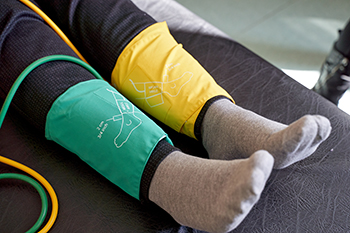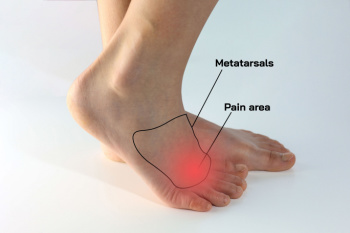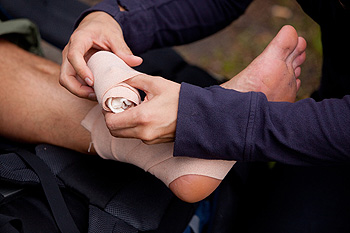Items filtered by date: February 2024
Hammertoe Stretches May Enhance Foot Flexibility

Hammertoe, a common foot deformity characterized by abnormal bending of the toe joints, can cause discomfort and limit mobility. Incorporating regular stretches into your daily routine can help alleviate tension and improve flexibility in the affected toes. One effective stretch is the toe extensor stretch, which involves gently pulling the affected toes upward and holding the position for several seconds to stretch the tendons and muscles on the top of the toes. Another beneficial stretch is the toe flexor stretch, where you interlace your fingers between the toes and gently press them together to stretch the toe joints and muscles on the bottom of the toes. Additionally, rolling a small ball or towel under the arches of your feet can help relieve tension and promote better toe alignment. By performing these stretches consistently and gently, individuals with hammertoes can enhance flexibility, reduce discomfort, and maintain better foot health overall. If you have hammertoe, and would like to know more about specific stretches to perform, it is suggested that you consult a podiatrist who can offer a tailored treatment plan.
Hammertoes can be a painful condition to live with. For more information, contact one of our podiatrists of Podiatry Associates of Victoria. Our doctors will answer any of your foot- and ankle-related questions.
Hammertoe
Hammertoe is a foot deformity that occurs due to an imbalance in the muscles, tendons, or ligaments that normally hold the toe straight. It can be caused by the type of shoes you wear, your foot structure, trauma, and certain disease processes.
Symptoms
- Painful and/or difficult toe movement
- Swelling
- Joint stiffness
- Calluses/Corns
- Physical deformity
Risk Factors
- Age – The risk of hammertoe increases with age
- Sex – Women are more likely to have hammertoe compared to men
- Toe Length – You are more likely to develop hammertoe if your second toe is longer than your big toe
- Certain Diseases – Arthritis and diabetes may make you more likely to develop hammertoe
Treatment
If you have hammertoe, you should change into a more comfortable shoe that provides enough room for your toes. Exercises such as picking up marbles may strengthen and stretch your toe muscles. Nevertheless, it is important to seek assistance from a podiatrist in order to determine the severity of your hammertoe and see which treatment option will work best for you.
If you have any questions, please feel free to contact our office located in Victoria, TX . We offer the newest diagnostic and treatment technologies for all your foot care needs.
Facts About the Ankle-Brachia Index Test

The Ankle-Brachial Index, or ABI, test is a diagnostic tool podiatrists use to assess peripheral arterial disease. This is a condition characterized by narrowed or blocked arteries, caused primarily by plaque buildup and which leads to poor blood flow to the legs. By measuring blood pressure at the ankle, at rest, and sometimes post-exercise, the ABI helps predict the severity of peripheral artery disease, a condition primarily caused by arterial narrowing or blockage due to plaque buildup. A normal ABI falls within the range of 1.0 to 1.4, indicating sufficient blood flow and minimal arterial obstruction, while values of 0.9 or lower suggest peripheral artery disease. Additionally, ABI values above 1.40 may also signal arterial stiffness and potential cardiovascular risks. Notably, a slight drop in ABI post-exercise further confirms the presence of peripheral artery disease. This test is instrumental not only in diagnosing lower extremity vascular issues but also in identifying individuals at heightened risk for heart attacks and strokes. Consequently, integrating ABI testing into routine podiatric assessments enables early detection and management of PAD. If you have peripheral artery disease symptoms, it is suggested that you schedule an appointment with a podiatrist for an examination and possibly ABI testing.
Peripheral artery disease can pose a serious risk to your health. It can increase the risk of stroke and heart attack. If you have symptoms of peripheral artery disease, consult with one of our podiatrists from Podiatry Associates of Victoria. Our doctors will assess your condition and provide you with quality foot and ankle treatment.
Peripheral artery disease (PAD) is when arteries are constricted due to plaque (fatty deposits) build-up. This results in less blood flow to the legs and other extremities. The main cause of PAD is atherosclerosis, in which plaque builds up in the arteries.
Symptoms
Symptoms of PAD include:
- Claudication (leg pain from walking)
- Numbness in legs
- Decrease in growth of leg hair and toenails
- Paleness of the skin
- Erectile dysfunction
- Sores and wounds on legs and feet that won’t heal
- Coldness in one leg
It is important to note that a majority of individuals never show any symptoms of PAD.
Diagnosis
While PAD occurs in the legs and arteries, Podiatrists can diagnose PAD. Podiatrists utilize a test called an ankle-brachial index (ABI). An ABI test compares blood pressure in your arm to you ankle to see if any abnormality occurs. Ultrasound and imaging devices may also be used.
Treatment
Fortunately, lifestyle changes such as maintaining a healthy diet, exercising, managing cholesterol and blood sugar levels, and quitting smoking, can all treat PAD. Medications that prevent clots from occurring can be prescribed. Finally, in some cases, surgery may be recommended.
If you have any questions, please feel free to contact our office located in Victoria, TX . We offer the newest diagnostic and treatment technologies for all your foot care needs.
Combatting Morton's Neuroma Pain for Peak Athletic Performance
 Morton's neuroma can have a significant impact on athletes, affecting their performance and overall foot comfort. Morton’s neuroma occurs when the tissue around one of the nerves connected to the toes thickens and becomes inflamed. Symptoms of Morton’s neuroma, including pain and discomfort in the ball of the foot, can be exacerbated during activities that involve repetitive stress on the front of the foot, like running or jumping. This is why forefoot pain and Morton’s neuroma are more common in athletes who use those repetitive motions. Athletes experiencing Morton's neuroma may find their agility and endurance compromised. However, there are strategies to manage pain so athletes can continue to exercise. Choosing appropriate footwear with ample cushioning and room for the toes is crucial. Additionally, incorporating orthotic inserts can provide extra support and alleviate pressure on the affected area. Athletes should also consider modifying their training routines to include low-impact exercises and activities that reduce stress on the forefoot. If you have pain in the ball of your foot, it is suggested that you consult with a podiatrist who can locate the source of the pain and provide treatment options for conditions such as Morton’s neuroma.
Morton's neuroma can have a significant impact on athletes, affecting their performance and overall foot comfort. Morton’s neuroma occurs when the tissue around one of the nerves connected to the toes thickens and becomes inflamed. Symptoms of Morton’s neuroma, including pain and discomfort in the ball of the foot, can be exacerbated during activities that involve repetitive stress on the front of the foot, like running or jumping. This is why forefoot pain and Morton’s neuroma are more common in athletes who use those repetitive motions. Athletes experiencing Morton's neuroma may find their agility and endurance compromised. However, there are strategies to manage pain so athletes can continue to exercise. Choosing appropriate footwear with ample cushioning and room for the toes is crucial. Additionally, incorporating orthotic inserts can provide extra support and alleviate pressure on the affected area. Athletes should also consider modifying their training routines to include low-impact exercises and activities that reduce stress on the forefoot. If you have pain in the ball of your foot, it is suggested that you consult with a podiatrist who can locate the source of the pain and provide treatment options for conditions such as Morton’s neuroma.
Morton’s neuroma is a very uncomfortable condition to live with. If you think you have Morton’s neuroma, contact one of our podiatrists of Podiatry Associates of Victoria. Our doctors will attend to all of your foot care needs and answer any of your related questions.
Morton’s Neuroma
Morton's neuroma is a painful foot condition that commonly affects the areas between the second and third or third and fourth toe, although other areas of the foot are also susceptible. Morton’s neuroma is caused by an inflamed nerve in the foot that is being squeezed and aggravated by surrounding bones.
What Increases the Chances of Having Morton’s Neuroma?
- Ill-fitting high heels or shoes that add pressure to the toe or foot
- Jogging, running or any sport that involves constant impact to the foot
- Flat feet, bunions, and any other foot deformities
Morton’s neuroma is a very treatable condition. Orthotics and shoe inserts can often be used to alleviate the pain on the forefront of the feet. In more severe cases, corticosteroids can also be prescribed. In order to figure out the best treatment for your neuroma, it’s recommended to seek the care of a podiatrist who can diagnose your condition and provide different treatment options.
If you have any questions, please feel free to contact our office located in Victoria, TX . We offer the newest diagnostic and treatment technologies for all your foot care needs.
Are Bunions Affecting Your Everyday Life?
Definition and Symptoms of Ankle Sprains

Ankle sprains, prevalent injuries that affect ligaments surrounding the ankle joint, can disrupt daily life and mobility. Occurring when the ankle is forced beyond its normal range of motion, these sprains lead to the stretching or tearing of ligaments, resulting in pain and swelling. The severity of an ankle sprain can vary, classified into three grades based on the extent of ligament damage. Common symptoms include localized pain, swelling, and difficulty bearing weight on the affected ankle. In more severe cases, individuals may experience bruising and instability. Recognizing the signs of an ankle sprain is vital for appropriate management, as untreated sprains can lead to chronic instability and long-term complications. An accurate understanding of the definition and symptoms of ankle sprains empowers individuals to seek timely intervention, facilitating a smoother recovery and a return to normal activities. If you have endured an ankle sprain, it is strongly suggested that you consult a podiatrist who can determine what the grade of the sprain is, and offer appropriate treatment methods.
Although ankle sprains are common, they aren’t always minor injuries. If you need your ankle injury looked at, contact one of our podiatrists from Podiatry Associates of Victoria. Our doctors can provide the care you need to keep you pain-free and on your feet.
How Does an Ankle Sprain Occur?
Ankle sprains are the result of a tear in the ligaments within the ankle. These injuries may happen when you make a rapid shifting movement while your foot is planted. A less common way to sprain your ankle is when your ankle rolls inward while your foot turns outward.
What Are the Symptoms?
- Pain at the sight of the tear
- Bruising/Swelling
- Ankle area is tender to touch
- In severe cases, may hear/feel something tear
- Skin discoloration
Preventing a Sprain
- Wearing appropriate shoes for the occasion
- Stretching before exercises and sports
- Knowing your limits
Treatment of a Sprain
In many cases, the RICE method (Rest, Ice, Compression, and Elevate) is used to treat ankle sprains. However, you should see a podiatrist to see which treatment option would work best with your injury. In severe cases, surgery may be required.
It is important to ask your doctor about rehab options after you receive treatment for your injury. Stretching, strength training, and balance exercises may help the ankle heal while also preventing further injury.
If you have any questions, please feel free to contact our office located in Victoria, TX . We offer the newest diagnostic and treatment technologies for all your foot care needs.

